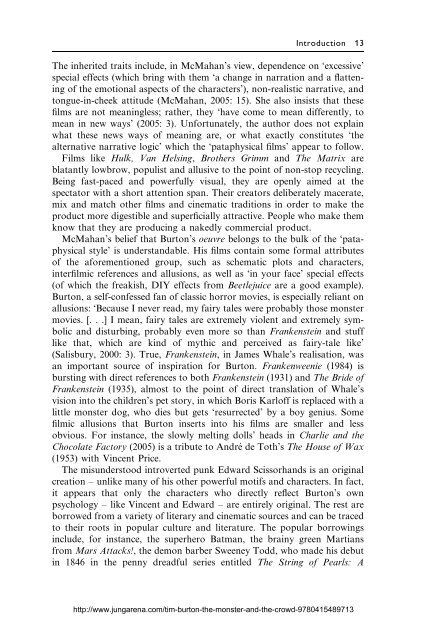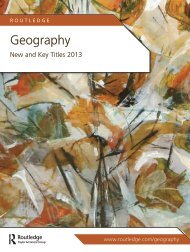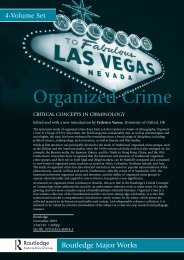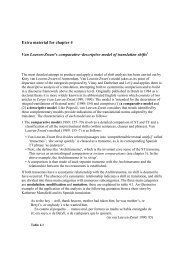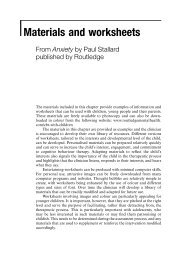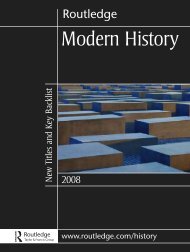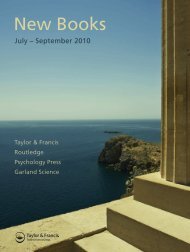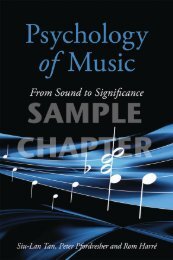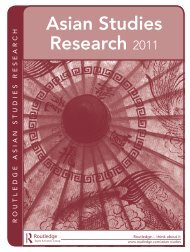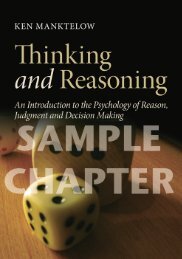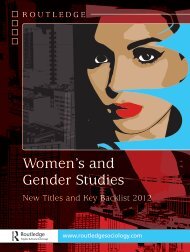Tim Burton: The Monster and the Crowd - A Post-Jungian Perspective
Tim Burton: The Monster and the Crowd - A Post-Jungian Perspective
Tim Burton: The Monster and the Crowd - A Post-Jungian Perspective
Create successful ePaper yourself
Turn your PDF publications into a flip-book with our unique Google optimized e-Paper software.
Introduction 13<br />
<strong>The</strong> inherited traits include, in McMahan's view, dependence on `excessive'<br />
special effects (which bring with <strong>the</strong>m `a change in narration <strong>and</strong> a ¯attening<br />
of <strong>the</strong> emotional aspects of <strong>the</strong> characters'), non-realistic narrative, <strong>and</strong><br />
tongue-in-cheek attitude (McMahan, 2005: 15). She also insists that <strong>the</strong>se<br />
®lms are not meaningless; ra<strong>the</strong>r, <strong>the</strong>y `have come to mean differently, to<br />
mean in new ways' (2005: 3). Unfortunately, <strong>the</strong> author does not explain<br />
what <strong>the</strong>se news ways of meaning are, or what exactly constitutes `<strong>the</strong><br />
alternative narrative logic' which <strong>the</strong> `pataphysical ®lms' appear to follow.<br />
Films like Hulk, Van Helsing, Bro<strong>the</strong>rs Grimm <strong>and</strong> <strong>The</strong> Matrix are<br />
blatantly lowbrow, populist <strong>and</strong> allusive to <strong>the</strong> point of non-stop recycling.<br />
Being fast-paced <strong>and</strong> powerfully visual, <strong>the</strong>y are openly aimed at <strong>the</strong><br />
spectator with a short attention span. <strong>The</strong>ir creators deliberately macerate,<br />
mix <strong>and</strong> match o<strong>the</strong>r ®lms <strong>and</strong> cinematic traditions in order to make <strong>the</strong><br />
product more digestible <strong>and</strong> super®cially attractive. People who make <strong>the</strong>m<br />
know that <strong>the</strong>y are producing a nakedly commercial product.<br />
McMahan's belief that <strong>Burton</strong>'s oeuvre belongs to <strong>the</strong> bulk of <strong>the</strong> `pataphysical<br />
style' is underst<strong>and</strong>able. His ®lms contain some formal attributes<br />
of <strong>the</strong> aforementioned group, such as schematic plots <strong>and</strong> characters,<br />
inter®lmic references <strong>and</strong> allusions, as well as `in your face' special effects<br />
(of which <strong>the</strong> freakish, DIY effects from Beetlejuice are a good example).<br />
<strong>Burton</strong>, a self-confessed fan of classic horror movies, is especially reliant on<br />
allusions: `Because I never read, my fairy tales were probably those monster<br />
movies. [. . .] I mean, fairy tales are extremely violent <strong>and</strong> extremely symbolic<br />
<strong>and</strong> disturbing, probably even more so than Frankenstein <strong>and</strong> stuff<br />
like that, which are kind of mythic <strong>and</strong> perceived as fairy-tale like'<br />
(Salisbury, 2000: 3). True, Frankenstein, in James Whale's realisation, was<br />
an important source of inspiration for <strong>Burton</strong>. Frankenweenie (1984) is<br />
bursting with direct references to both Frankenstein (1931) <strong>and</strong> <strong>The</strong> Bride of<br />
Frankenstein (1935), almost to <strong>the</strong> point of direct translation of Whale's<br />
vision into <strong>the</strong> children's pet story, in which Boris Karloff is replaced with a<br />
little monster dog, who dies but gets `resurrected' by a boy genius. Some<br />
®lmic allusions that <strong>Burton</strong> inserts into his ®lms are smaller <strong>and</strong> less<br />
obvious. For instance, <strong>the</strong> slowly melting dolls' heads in Charlie <strong>and</strong> <strong>the</strong><br />
Chocolate Factory (2005) is a tribute to Andre de Toth's <strong>The</strong> House of Wax<br />
(1953) with Vincent Price.<br />
<strong>The</strong> misunderstood introverted punk Edward Scissorh<strong>and</strong>s is an original<br />
creation ± unlike many of his o<strong>the</strong>r powerful motifs <strong>and</strong> characters. In fact,<br />
it appears that only <strong>the</strong> characters who directly re¯ect <strong>Burton</strong>'s own<br />
psychology ± like Vincent <strong>and</strong> Edward ± are entirely original. <strong>The</strong> rest are<br />
borrowed from a variety of literary <strong>and</strong> cinematic sources <strong>and</strong> can be traced<br />
to <strong>the</strong>ir roots in popular culture <strong>and</strong> literature. <strong>The</strong> popular borrowings<br />
include, for instance, <strong>the</strong> superhero Batman, <strong>the</strong> brainy green Martians<br />
from Mars Attacks!, <strong>the</strong> demon barber Sweeney Todd, who made his debut<br />
in 1846 in <strong>the</strong> penny dreadful series entitled <strong>The</strong> String of Pearls: A<br />
http://www.jungarena.com/tim-burton-<strong>the</strong>-monster-<strong>and</strong>-<strong>the</strong>-crowd-9780415489713


